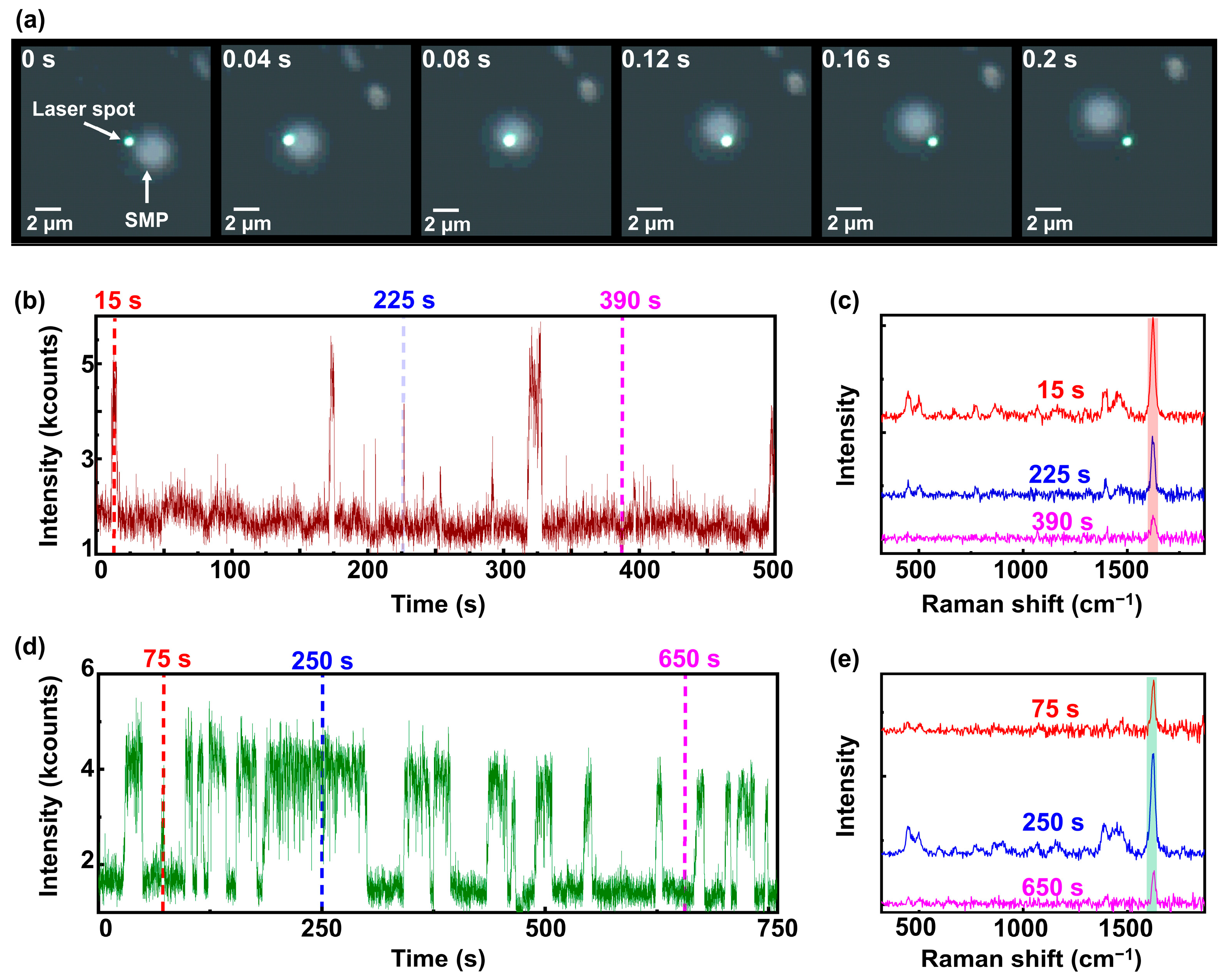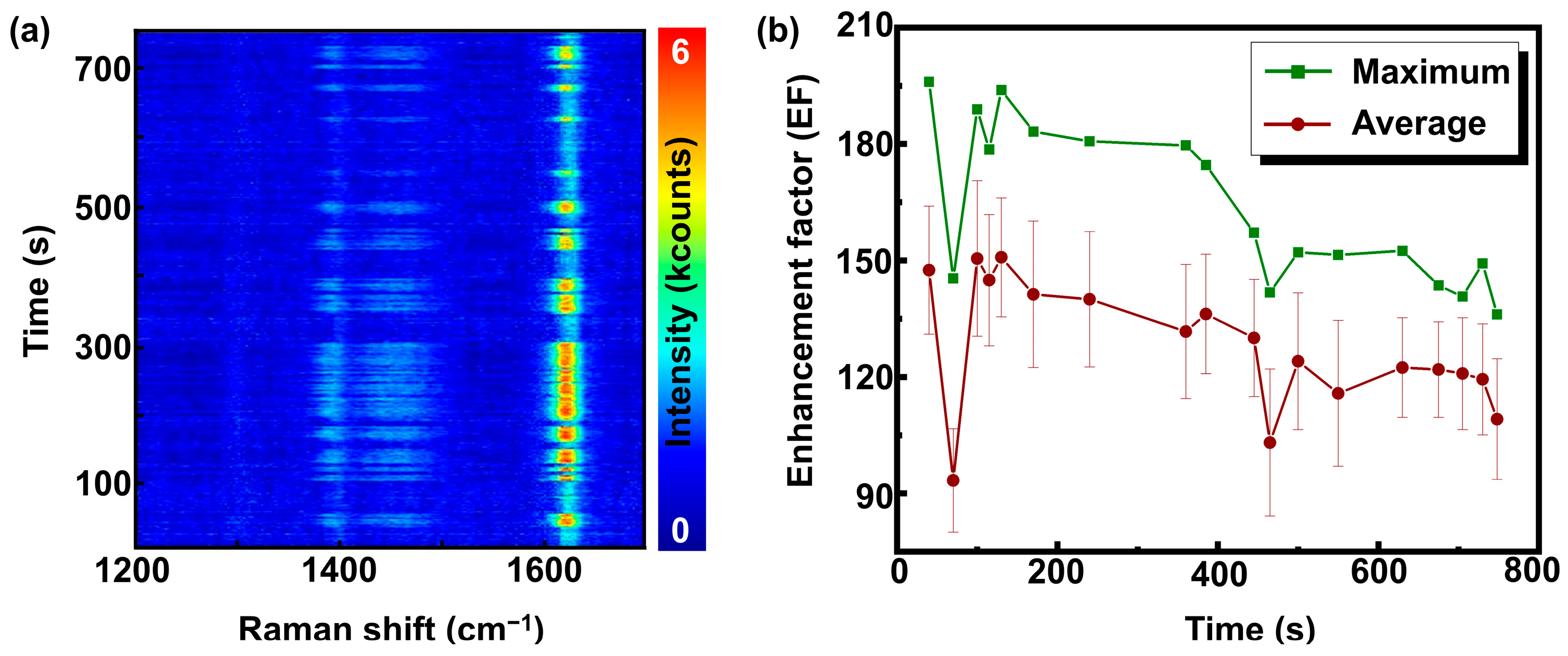Three-Dimensional (3D) Surface-Enhanced Raman Spectroscopy (SERS) Substrates for Sensing Low-Concentration Molecules in Solution
Abstract
1. Introduction
2. Materials and Methods
2.1. Fabrication of Mercapto-Functionalized SMPs
2.2. Synthesizing SMPs with Metal Nanoparticles
Tollens’ Reagent (Ag)
2.3. SERS Experiments
2.4. Preparation of Solution
2.4.1. Glycerin–MB Solution
2.4.2. Water–MB Solution
2.5. Scanning Electron Microscopy (SEM)
3. Results and Discussion
4. Conclusions
Supplementary Materials
Author Contributions
Funding
Data Availability Statement
Acknowledgments
Conflicts of Interest
References
- Fleischmann, M.; Hendra, P.J.; McQuillan, A.J. Raman spectra of pyridine adsorbed at a silver electrode. Chem. Phys. Lett. 1974, 26, 163–166. [Google Scholar] [CrossRef]
- Pettinger, B.; Wenning, U.; Wetzel, H. Surface plasmon enhanced Raman scattering frequency and angular resonance of Raman scattered light from pyridine on Au, Ag and Cu electrodes. Surf. Sci. 1980, 101, 409–416. [Google Scholar] [CrossRef]
- Zhang, J.; Chen, S.; Gong, T.; Zhang, X.; Zhu, Y. Tapered Fiber Probe Modified by Ag Nanoparticles for SERS Detection. Plasmonics 2016, 11, 743–751. [Google Scholar] [CrossRef]
- Guo, Y.; Zhang, L.; You, H.; Fang, J. A solution-based SERS sensing protocol via the ultra-rapid and highly efficient molecule enrichment strategy. Sens. Actuators B Chem. 2022, 367, 132064. [Google Scholar] [CrossRef]
- Mosier-Boss, P.A. Review of SERS Substrates for Chemical Sensing. Nanomaterials 2017, 7, 142. [Google Scholar] [CrossRef]
- Laurence, T.A.; Braun, G.; Talley, C.; Schwartzberg, A.; Moskovits, M.; Reich, N.; Huser, T. Rapid, solution-based characterization of optimized SERS nanoparticle substrates. J. Am. Chem. Soc. 2009, 131, 162–169. [Google Scholar] [CrossRef]
- Amin, M.U.; Zhang, R.; Li, L.; You, H.; Fang, J. Solution-Based SERS Detection of Weak Surficial Affinity Molecules Using Cysteamine-Modified Au Bipyramids. Anal. Chem. 2021, 93, 7657–7664. [Google Scholar] [CrossRef] [PubMed]
- Wang, H.; Fang, J.; Xu, J.; Wang, F.; Sun, B.; He, S.; Sun, G.; Liu, H. A hanging plasmonic droplet: Three-dimensional SERS hotspots for a highly sensitive multiplex detection of amino acids. Analyst 2015, 140, 2973–2978. [Google Scholar] [CrossRef]
- Mukherjee, A.; Liu, Q.; Wackenhut, F.; Dai, F.; Fleischer, M.; Adam, P.-M.; Meixner, A.J.; Brecht, M. Gradient SERS Substrates with Multiple Resonances for Analyte Screening: Fabrication and SERS Applications. Molecules 2022, 27, 5097. [Google Scholar] [CrossRef]
- Liu, Q.; Wackenhut, F.; Wang, L.; Hauler, O.; Roldao, J.C.; Adam, P.-M.; Brecht, M.; Gierschner, J.; Meixner, A.J. Direct Observation of Structural Heterogeneity and Tautomerization of Single Hypericin Molecules. J. Phys. Chem. Lett. 2021, 12, 1025–1031. [Google Scholar] [CrossRef]
- Geladari, O.; Haizmann, P.; Maier, A.; Strienz, M.; Eberle, M.; Scheele, M.; Peisert, H.; Schnepf, A.; Chassé, T.; Braun, K.; et al. Direct laser induced writing of high precision gold nanosphere SERS patterns. Nanoscale Adv. 2024, 6, 1213–1217. [Google Scholar] [CrossRef] [PubMed]
- Wu, L.-A.; Li, W.-E.; Lin, D.-Z.; Chen, Y.-F. Three-Dimensional SERS Substrates Formed with Plasmonic Core-Satellite Nanostructures. Sci. Rep. 2017, 7, 13066. [Google Scholar] [CrossRef] [PubMed]
- Lee, H.K.; Lee, Y.H.; Phang, I.Y.; Wei, J.; Miao, Y.-E.; Liu, T.; Ling, X.Y. Plasmonic liquid marbles: A miniature substrate-less SERS platform for quantitative and multiplex ultratrace molecular detection. Angew. Chem. Int. Ed. Engl. 2014, 53, 5054–5058. [Google Scholar] [CrossRef] [PubMed]
- Gupta, R.; Rastogi, P.K.; Ganesan, V.; Yadav, D.K.; Sonkar, P.K. Gold nanoparticles decorated mesoporous silica microspheres: A proficient electrochemical sensing scaffold for hydrazine and nitrobenzene. Sens. Actuators B Chem. 2017, 239, 970–978. [Google Scholar] [CrossRef]
- Mukherjee, A.; Wackenhut, F.; Dohare, A.; Horneber, A.; Lorenz, A.; Müchler, H.; Meixner, A.J.; Mayer, H.A.; Brecht, M. Three-Dimensional (3D) Surface-Enhanced Raman Spectroscopy (SERS) Substrates: Fabrication and SERS Applications. J. Phys. Chem. C 2023, 127, 13689–13698. [Google Scholar] [CrossRef]
- Li, J.-M.; Ma, W.-F.; Wei, C.; Guo, J.; Hu, J.; Wang, C.-C. Poly(styrene-co-acrylic acid) core and silver nanoparticle/silica shell composite microspheres as high performance surface-enhanced Raman spectroscopy (SERS) substrate and molecular barcode label. J. Mater. Chem. 2011, 21, 5992. [Google Scholar] [CrossRef]
- Li, J.-M.; Ma, W.-F.; Wei, C.; You, L.-J.; Guo, J.; Hu, J.; Wang, C.-C. Detecting trace melamine in solution by SERS using Ag nanoparticle coated poly(styrene-co-acrylic acid) nanospheres as novel active substrates. Langmuir 2011, 27, 14539–14544. [Google Scholar] [CrossRef]
- Liu, T.; Li, D.; Yang, D.; Jiang, M. An improved seed-mediated growth method to coat complete silver shells onto silica spheres for surface-enhanced Raman scattering. Colloids Surf. A Physicochem. Eng. Asp. 2011, 387, 17–22. [Google Scholar] [CrossRef]
- Jensen, R.A.; Sherin, J.; Emory, S.R. Single nanoparticle based optical pH probe. Appl. Spectrosc. 2007, 61, 832–838. [Google Scholar] [CrossRef]
- Kim, H.; Lee, S.; Seo, H.W.; Kang, B.; Moon, J.; Lee, K.G.; Yong, D.; Kang, H.; Jung, J.; Lim, E.-K.; et al. Clustered Regularly Interspaced Short Palindromic Repeats-Mediated Surface-Enhanced Raman Scattering Assay for Multidrug-Resistant Bacteria. ACS Nano 2020, 14, 17241–17253. [Google Scholar] [CrossRef]
- Chen, L.-M.; Liu, Y.-N. Surface-enhanced Raman detection of melamine on silver-nanoparticle-decorated silver/carbon nanospheres: Effect of metal ions. ACS Appl. Mater. Interfaces 2011, 3, 3091–3096. [Google Scholar] [CrossRef] [PubMed]
- Cai, W.; Wang, W.; Lu, L.; Chen, T. Coating sulfonated polystyrene microspheres with highly dense gold nanoparticle shell for SERS application. Colloid Polym. Sci. 2013, 291, 2023–2029. [Google Scholar] [CrossRef]
- Trinh, B.T.; Cho, H.; Lee, D.; Omelianovych, O.; Kim, T.; Nguyen, S.K.; Choi, H.-S.; Kim, H.; Yoon, I. Dual-Functional Solar-to-Steam Generation and SERS Detection Substrate Based on Plasmonic Nanostructure. Nanomaterials 2023, 13, 1003. [Google Scholar] [CrossRef] [PubMed]
- Lupa, D.; Oćwieja, M.; Piergies, N.; Baliś, A.; Paluszkiewicz, C.; Adamczyk, Z. Gold nanoparticles deposited on silica microparticles—Electrokinetic characteristics and application in SERS. Colloid Interface Sci. Commun. 2019, 33, 100219. [Google Scholar] [CrossRef]
- Yang, H.; Lu, X.; Xin, Z. One-Step Synthesis of Nonspherical Organosilica Particles with Tunable Morphology. Langmuir 2018, 34, 11723–11728. [Google Scholar] [CrossRef]
- Zhou, Q.; Xiang, H.; Fan, H.; Yang, X.; Zhao, N.; Xu, J. Facile fabrication of golf ball-like hollow microspheres of organic-inorganic silica. J. Mater. Chem. 2011, 21, 13056. [Google Scholar] [CrossRef]
- Mukherjee, A.; Lorenz, A.; Brecht, M. Determination and Monitoring of Quality Parameters: A Detailed Study of Optical Elements of a Lens-Based Raman Spectrometer. Appl. Spectrosc. 2022, 76, 199–206. [Google Scholar] [CrossRef]
- Tu, K.T.; Chung, C.K. Enhancement of Surface Raman Spectroscopy Performance by Silver Nanoparticles on Resin Nanorods Arrays from Anodic Aluminum Oxide Template. J. Electrochem. Soc. 2017, 164, B3081–B3086. [Google Scholar] [CrossRef]
- Mudalige, A.; Pemberton, J.E. Raman spectroscopy of glycerol/D2O solutions. Vib. Spectrosc. 2007, 45, 27–35. [Google Scholar] [CrossRef]
- Le Ru, E.C.; Meyer, M.; Etchegoin, P.G. Proof of single-molecule sensitivity in surface enhanced Raman scattering (SERS) by means of a two-analyte technique. J. Phys. Chem. B 2006, 110, 1944–1948. [Google Scholar] [CrossRef]
- Etchegoin, P.G.; Meyer, M.; Blackie, E.; Le Ru, E.C. Statistics of single-molecule surface enhanced Raman scattering signals: Fluctuation analysis with multiple analyte techniques. Anal. Chem. 2007, 79, 8411–8415. [Google Scholar] [CrossRef] [PubMed]
- Ansar, S.M.; Li, X.; Zou, S.; Zhang, D. Quantitative Comparison of Raman Activities, SERS Activities, and SERS Enhancement Factors of Organothiols: Implication to Chemical Enhancement. J. Phys. Chem. Lett. 2012, 3, 560–565. [Google Scholar] [CrossRef] [PubMed]
- Félidj, N.; Aubard, J.; Lévi, G.; Krenn, J.R.; Schider, G.; Leitner, A.; Aussenegg, F.R. Enhanced substrate-induced coupling in two-dimensional gold nanoparticle arrays. Phys. Rev. B 2002, 66, 245407. [Google Scholar] [CrossRef]
- Lassiter, J.B.; Aizpurua, J.; Hernandez, L.I.; Brandl, D.W.; Romero, I.; Lal, S.; Hafner, J.H.; Nordlander, P.; Halas, N.J. Close encounters between two nanoshells. Nano Lett. 2008, 8, 1212–1218. [Google Scholar] [CrossRef]




Disclaimer/Publisher’s Note: The statements, opinions and data contained in all publications are solely those of the individual author(s) and contributor(s) and not of MDPI and/or the editor(s). MDPI and/or the editor(s) disclaim responsibility for any injury to people or property resulting from any ideas, methods, instructions or products referred to in the content. |
© 2024 by the authors. Licensee MDPI, Basel, Switzerland. This article is an open access article distributed under the terms and conditions of the Creative Commons Attribution (CC BY) license (https://creativecommons.org/licenses/by/4.0/).
Share and Cite
Mukherjee, A.; Wackenhut, F.; Meixner, A.J.; Mayer, H.A.; Brecht, M. Three-Dimensional (3D) Surface-Enhanced Raman Spectroscopy (SERS) Substrates for Sensing Low-Concentration Molecules in Solution. Nanomaterials 2024, 14, 1728. https://doi.org/10.3390/nano14211728
Mukherjee A, Wackenhut F, Meixner AJ, Mayer HA, Brecht M. Three-Dimensional (3D) Surface-Enhanced Raman Spectroscopy (SERS) Substrates for Sensing Low-Concentration Molecules in Solution. Nanomaterials. 2024; 14(21):1728. https://doi.org/10.3390/nano14211728
Chicago/Turabian StyleMukherjee, Ashutosh, Frank Wackenhut, Alfred J. Meixner, Hermann A. Mayer, and Marc Brecht. 2024. "Three-Dimensional (3D) Surface-Enhanced Raman Spectroscopy (SERS) Substrates for Sensing Low-Concentration Molecules in Solution" Nanomaterials 14, no. 21: 1728. https://doi.org/10.3390/nano14211728
APA StyleMukherjee, A., Wackenhut, F., Meixner, A. J., Mayer, H. A., & Brecht, M. (2024). Three-Dimensional (3D) Surface-Enhanced Raman Spectroscopy (SERS) Substrates for Sensing Low-Concentration Molecules in Solution. Nanomaterials, 14(21), 1728. https://doi.org/10.3390/nano14211728





